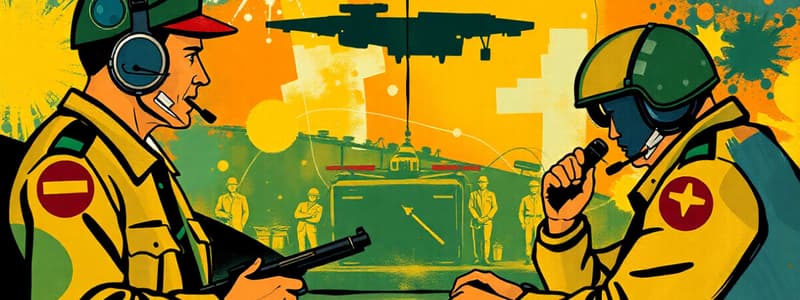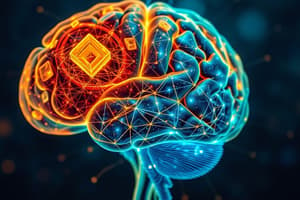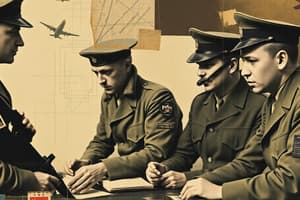Podcast
Questions and Answers
What is the primary responsibility of the G-2/S-2?
What is the primary responsibility of the G-2/S-2?
- Performing combat assessment.
- Advising the commander on intelligence matters. (correct)
- Conducting intelligence operations for the MI unit.
- Supervising the special security office.
Which of the following is NOT a task that the G-2/S-2 is responsible for?
Which of the following is NOT a task that the G-2/S-2 is responsible for?
- Conducting knowledge management.
- Leading all intelligence operations within the MI unit. (correct)
- Supervising command and personnel security programs.
- Developing the intelligence portion of the Course of Action (COA).
In what capacity does the G-2/S-2 support the commander's decisions?
In what capacity does the G-2/S-2 support the commander's decisions?
- By directly executing intelligence operations.
- By conducting combat assessments and evaluations.
- By managing and coordinating intelligence resources.
- By providing intelligence analysis and advice. (correct)
What is the purpose of intelligence synchronization as it relates to the G-2/S-2?
What is the purpose of intelligence synchronization as it relates to the G-2/S-2?
What is the role of the G-2/S-2 in knowledge management?
What is the role of the G-2/S-2 in knowledge management?
Which of the following staff sections does the G-2/S-2 evaluate for physical security vulnerabilities?
Which of the following staff sections does the G-2/S-2 evaluate for physical security vulnerabilities?
Which of these actions is NOT a responsibility of the G-2/S-2 in supporting security programs?
Which of these actions is NOT a responsibility of the G-2/S-2 in supporting security programs?
Which of these represents the purpose of Intelligence Support to Risk Management?
Which of these represents the purpose of Intelligence Support to Risk Management?
What is the primary driver for overall information collection planning?
What is the primary driver for overall information collection planning?
How is collection management integrated with information collection planning?
How is collection management integrated with information collection planning?
Which of the following is NOT inherently included in conducting collection management?
Which of the following is NOT inherently included in conducting collection management?
What is the primary focus of the intelligence warfighting function?
What is the primary focus of the intelligence warfighting function?
What role do specific information requirements (SIRs) play in the intelligence process?
What role do specific information requirements (SIRs) play in the intelligence process?
How do collection management and intelligence analysis support each other?
How do collection management and intelligence analysis support each other?
Who is responsible for conducting collection management?
Who is responsible for conducting collection management?
What is the ultimate goal of effectively conducted collection management and intelligence analysis?
What is the ultimate goal of effectively conducted collection management and intelligence analysis?
What are the four steps of the IPOE process?
What are the four steps of the IPOE process?
When conducting IPOE, it is crucial to consider all domains and dimensions, but what else is essential to focus collection and analysis?
When conducting IPOE, it is crucial to consider all domains and dimensions, but what else is essential to focus collection and analysis?
What is the primary responsibility of the G-3/S-3 in the context of collection orchestration?
What is the primary responsibility of the G-3/S-3 in the context of collection orchestration?
What is the primary difference between the operational-level model and the joint operational-level model for collection management?
What is the primary difference between the operational-level model and the joint operational-level model for collection management?
What is the purpose of the IPOE process in relation to the commander's visualization of the desired end state?
What is the purpose of the IPOE process in relation to the commander's visualization of the desired end state?
How does the IPOE process contribute to the commander's understanding of the operational environment?
How does the IPOE process contribute to the commander's understanding of the operational environment?
What are the five key tasks of the collection management process?
What are the five key tasks of the collection management process?
What is the purpose of collection orchestration?
What is the purpose of collection orchestration?
What is the significance of the 'stability mechanisms' aspect of IPOE?
What is the significance of the 'stability mechanisms' aspect of IPOE?
How does the staff collaborate during IPOE?
How does the staff collaborate during IPOE?
What is the role of the commander in the collection management process?
What is the role of the commander in the collection management process?
What information is used to develop an effective collection management plan?
What information is used to develop an effective collection management plan?
What is the primary function of the IPOE process in relation to the intelligence warfighting function?
What is the primary function of the IPOE process in relation to the intelligence warfighting function?
The text emphasizes the need for staff to thoroughly consider the civil considerations that are significant to the mission. What does this suggest about the importance of civil considerations in IPOE?
The text emphasizes the need for staff to thoroughly consider the civil considerations that are significant to the mission. What does this suggest about the importance of civil considerations in IPOE?
What is the primary advantage of using the joint operational-level model for collection management?
What is the primary advantage of using the joint operational-level model for collection management?
Which of these is NOT a component of the collection management process?
Which of these is NOT a component of the collection management process?
What is the primary impact of intelligence that arrives too late for commanders to make decisions?
What is the primary impact of intelligence that arrives too late for commanders to make decisions?
Which of the following is NOT a potential challenge or risk related to relying solely on single-source intelligence?
Which of the following is NOT a potential challenge or risk related to relying solely on single-source intelligence?
What is the primary objective of all-source analysis?
What is the primary objective of all-source analysis?
Why is specialized expertise from outside the traditional military staff often needed for cyberspace intelligence?
Why is specialized expertise from outside the traditional military staff often needed for cyberspace intelligence?
Which of the following is NOT a doctrinal task referred to as IWFTs?
Which of the following is NOT a doctrinal task referred to as IWFTs?
Who is primarily responsible for establishing and revising the intelligence architecture?
Who is primarily responsible for establishing and revising the intelligence architecture?
Which of the following accurately describes the intelligence architecture?
Which of the following accurately describes the intelligence architecture?
Why is it important for the intelligence staff and MI units to collaborate in completing the intelligence warfighting function tasks (IWFTs)?
Why is it important for the intelligence staff and MI units to collaborate in completing the intelligence warfighting function tasks (IWFTs)?
What are the main limitations of the COP (Common Operational Picture) in regards to threat situation and civil considerations?
What are the main limitations of the COP (Common Operational Picture) in regards to threat situation and civil considerations?
What actions are required from the intelligence staff to ensure the COP remains timely, accurate, and relevant?
What actions are required from the intelligence staff to ensure the COP remains timely, accurate, and relevant?
What are some challenges faced by the intelligence staff in validating and maintaining the threat portions of the COP?
What are some challenges faced by the intelligence staff in validating and maintaining the threat portions of the COP?
What is a key characteristic of a "composite" location in the COP?
What is a key characteristic of a "composite" location in the COP?
What does the term "somewhat latent" refer to in the context of the COP?
What does the term "somewhat latent" refer to in the context of the COP?
How does the COP assist in achieving shared situational understanding across multiple domains?
How does the COP assist in achieving shared situational understanding across multiple domains?
What are some of the factors that can complicate the maintenance of a COP in a multinational environment?
What are some of the factors that can complicate the maintenance of a COP in a multinational environment?
What are the main responsibilities of the intelligence staff in relation to the COP?
What are the main responsibilities of the intelligence staff in relation to the COP?
Flashcards
Collection Management
Collection Management
The process guiding overall information collection planning within military operations.
Collection Management Plan
Collection Management Plan
A structured plan developed to organize and prioritize collection efforts in intelligence.
Intelligence Handover Lines
Intelligence Handover Lines
Graphic measures used to delineate areas of responsibility in collection management.
CCIRs
CCIRs
Signup and view all the flashcards
PIRs
PIRs
Signup and view all the flashcards
SIRs
SIRs
Signup and view all the flashcards
PED Activities
PED Activities
Signup and view all the flashcards
Collaboration in Intelligence
Collaboration in Intelligence
Signup and view all the flashcards
Intelligence Support to Operations
Intelligence Support to Operations
Signup and view all the flashcards
Psychological Operations Support
Psychological Operations Support
Signup and view all the flashcards
Commander's Intelligence Advisor
Commander's Intelligence Advisor
Signup and view all the flashcards
Intelligence Process Execution
Intelligence Process Execution
Signup and view all the flashcards
Intelligence Synchronization
Intelligence Synchronization
Signup and view all the flashcards
Combat Assessment Support
Combat Assessment Support
Signup and view all the flashcards
Personel Security Programs
Personel Security Programs
Signup and view all the flashcards
Collection Management Responsibility
Collection Management Responsibility
Signup and view all the flashcards
G-3/S-3 Role
G-3/S-3 Role
Signup and view all the flashcards
G-2/S-2 Role
G-2/S-2 Role
Signup and view all the flashcards
All-Source Analysis
All-Source Analysis
Signup and view all the flashcards
Single-Source Intelligence
Single-Source Intelligence
Signup and view all the flashcards
Intelligence Warfighting Function Tasks (IWFTs)
Intelligence Warfighting Function Tasks (IWFTs)
Signup and view all the flashcards
Cyberspace Intelligence Support
Cyberspace Intelligence Support
Signup and view all the flashcards
Operational Environment (OE)
Operational Environment (OE)
Signup and view all the flashcards
Intelligence Architecture
Intelligence Architecture
Signup and view all the flashcards
COP (Common Operational Picture)
COP (Common Operational Picture)
Signup and view all the flashcards
Timeliness in COP
Timeliness in COP
Signup and view all the flashcards
Latent Locations
Latent Locations
Signup and view all the flashcards
Composite Locations
Composite Locations
Signup and view all the flashcards
Threat Portions of COP
Threat Portions of COP
Signup and view all the flashcards
Collaborative Planning via COP
Collaborative Planning via COP
Signup and view all the flashcards
SITUATIONAL UNDERSTANDING
SITUATIONAL UNDERSTANDING
Signup and view all the flashcards
Multinational COP Challenges
Multinational COP Challenges
Signup and view all the flashcards
IPOE
IPOE
Signup and view all the flashcards
Commander’s AOI
Commander’s AOI
Signup and view all the flashcards
Civil Considerations
Civil Considerations
Signup and view all the flashcards
MDMP
MDMP
Signup and view all the flashcards
Threat COAs
Threat COAs
Signup and view all the flashcards
Environmental Effects
Environmental Effects
Signup and view all the flashcards
Continuous Analysis
Continuous Analysis
Signup and view all the flashcards
Army Collection Orchestration
Army Collection Orchestration
Signup and view all the flashcards
Information Collection Requirements
Information Collection Requirements
Signup and view all the flashcards
Multidiscipline Collection Strategy
Multidiscipline Collection Strategy
Signup and view all the flashcards
Five tasks of Collection Management Process
Five tasks of Collection Management Process
Signup and view all the flashcards
IPOE Outputs
IPOE Outputs
Signup and view all the flashcards
Joint Operational-Level Model
Joint Operational-Level Model
Signup and view all the flashcards
Study Notes
Major Intelligence Activities
- Doctrinal concepts in part I (intelligence and operational fundamentals) are key for understanding part II (major intelligence activities).
- This includes intelligence staff support (Chapter 5) and intelligence operations (Chapter 6).
- Chapters 5 and 6 provide the foundation for understanding fighting for intelligence.
- Chapter 5 focuses on Intelligence Staff Support.
Intelligence Staff Support - Overview
- Staffs support commanders in making decisions, implementing decisions, and integrating/synchronizing combat power.
- Effective staffs increase unit effectiveness.
- Staffs provide timely and relevant information, analysis, and estimates.
- They prepare plans, orders, and assist in controlling operations, assessing operation progress.
- Primary responsibility is supporting the commander and assisting subordinate commanders, staffs, and units.
- Also informing units and organizations outside the headquarters.
Intelligence Staff Support - Multifaceted Support
- Intelligence support is complex, demanding the G-2/S-2 and staff work across technological domains to meet multiple challenges.
- Challenges include the operational environment, intelligence capabilities, time constraints, and the demands of multi-domain operations.
- A multitude of factors within the operational environment (OE) affect the process, including human, information, and physical dimensions.
- Staffs have to contend with sophisticated intelligence capabilities.
- Time constraints during the process are a significant factor.
Intelligence Staff Composition and Responsibilities
- Intelligence staff composition varies by echelon.
- G-2/S-2 organizes the staff to meet operational needs.
- Certain functions are common across echelons, and permanent teams are preferable over ad-hoc ones.
- Intelligence staff elements often reside in the main CP intelligence cell.
- Cross-functional groups like information collection, protection, and targeting help with staff integration.
Collection Management Functions
- Collection management converts intelligence requirements into collection needs.
- It sets priorities, tasks agencies, and monitors collection results.
- It seeks appropriate collection sources/agencies to ensure adequate information for operations.
- Essential for intelligence reach, RFIs, and collection requests.
Intelligence Analysis Continuum
- Intelligence analysis is more than IPOE (intelligence preparation of the operational environment).
- It supports commander's decisions, situational understanding, and information advantage activities.
- It helps during targeting, planning, deception, and operational assessments.
Operational Variables (Intelligence for Contingency)
- Moving from generalized analysis, information, and intelligence to contingency is crucial.
- This can involve joint IPOE (intelligence preparation of the operational environment) or higher-level Army IPOE. Lower-level units may not perform IPOE initially.
- Threat systems analysis is a separate, important task.
- Operational variables and domain/dimension analyses are key to understanding the situation.
Intelligence Preparation of Operational Environment (IPOE) Process Steps
- There are four steps in the IPOE process:
- Define the Operational Environment(OE)
- Describe environmental effects on operations
- Evaluate the threat.
- Determine threat Courses of Action (COAs.)
Studying That Suits You
Use AI to generate personalized quizzes and flashcards to suit your learning preferences.




